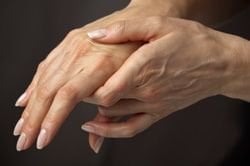 In general terms, arthritis is a gradual breakdown or deterioration of the joint spaces in your musculoskeletal system. According to some experts, 8 out of 10 Americans over the age of 55 suffer from one form of arthritis or another. In many cases, arthritis can become so painful and debilitating, simple tasks such as opening a jar or holding a pencil can be difficult. Arthritis affects everyone in different ways. In some, joints in the spine, fingers, wrists, shoulders, knees—even toes—lose their normal shape and large amounts of fluid and debris fill the joint space.
In general terms, arthritis is a gradual breakdown or deterioration of the joint spaces in your musculoskeletal system. According to some experts, 8 out of 10 Americans over the age of 55 suffer from one form of arthritis or another. In many cases, arthritis can become so painful and debilitating, simple tasks such as opening a jar or holding a pencil can be difficult. Arthritis affects everyone in different ways. In some, joints in the spine, fingers, wrists, shoulders, knees—even toes—lose their normal shape and large amounts of fluid and debris fill the joint space.
There are many causes of arthritis. A major cause is simply age. Injury or suppressed or weakened immune systems are others. Some people have no choiceit is simply hereditary.
In most people, the body responds to the onset of arthritis by making extra bone. Your body makes this material in an attempt to shore up the degenerating joint. This additional material, or overgrowth, is called a bone spur or osteophyte. Bone spurs are typically found in the joint or disc spaces, where cartilage has begun to break down or deteriorate. Bone spurs sometimes block the spaces where nerve roots leave the spinal canal.
There are many symptoms of arthritis, including:
- Burning
- Cramping
- Inflammation
- Joint pain
- Loss of muscle control
- Muscle spasms
- Numbness
- Pain
- Stabbing pain in the extremities
Major types of arthritis include osteoarthritis and rheumatoid arthritis.
The degenerative form of arthritis that mostly affects the elderly is called osteoarthritis. In some, osteoarthritis may affect the spine’s facet joints, making it extremely painful to bend or twist. Osteoarthritis causes the cartilage to break down and away from the joints.
Stripped of their protective material, the joints begin rubbing against each other, causing pain and impeding movement. This action further irritates the surrounding nerves. Advanced forms of spinal osteoarthritis lead to disc collapse and other problems. An equally painful and destructive form of arthritis is called rheumatoid arthritis.
Rheumatoid arthritis causes inflammation of the joint tissues, leading to pain, weakness, low red blood cell count (anemia), and loss of appetite.
Physical therapy has been shown to help people with arthritis.
Physical therapy can be used to reduce pain, restore mobility, function, strength, and flexibility, and prevent unnecessary disability.
Physical therapy can also help people suffering from arthritis to self-manage their pain, giving them a sense of confidence, empowerment, and hope.
Common exercises may include wall walking (which targets the shoulder joints) and the chair rise (which strengthens your legs and makes standing and sitting safer). Good examples of appropriate activities for those living with arthritis include aquatic exercises (such as swimming), walking, bicycling, golf, and cross-country skiing.
 In general terms, arthritis is a gradual breakdown or deterioration of the joint spaces in your musculoskeletal system. According to some experts, 8 out of 10 Americans over the age of 55 suffer from one form of arthritis or another. In many cases, arthritis can become so painful and debilitating, simple tasks such as opening a jar or holding a pencil can be difficult. Arthritis affects everyone in different ways. In some, joints in the spine, fingers, wrists, shoulders, knees—even toes—lose their normal shape and large amounts of fluid and debris fill the joint space.
In general terms, arthritis is a gradual breakdown or deterioration of the joint spaces in your musculoskeletal system. According to some experts, 8 out of 10 Americans over the age of 55 suffer from one form of arthritis or another. In many cases, arthritis can become so painful and debilitating, simple tasks such as opening a jar or holding a pencil can be difficult. Arthritis affects everyone in different ways. In some, joints in the spine, fingers, wrists, shoulders, knees—even toes—lose their normal shape and large amounts of fluid and debris fill the joint space. Like exercise, proper nutrition provides a wealth of benefits‚ both physical and emotional‚ that contribute to your body’s strength and its ability to ward off disease and disability.
Like exercise, proper nutrition provides a wealth of benefits‚ both physical and emotional‚ that contribute to your body’s strength and its ability to ward off disease and disability. Many of us are familiar with the terms “slipped disc” and “herniated disc.” But few people outside the medical profession truly understand how critical their spinal discs are. Without discs, our vertebrae would grind against each other and our spines would collapse under the strain.
Many of us are familiar with the terms “slipped disc” and “herniated disc.” But few people outside the medical profession truly understand how critical their spinal discs are. Without discs, our vertebrae would grind against each other and our spines would collapse under the strain.